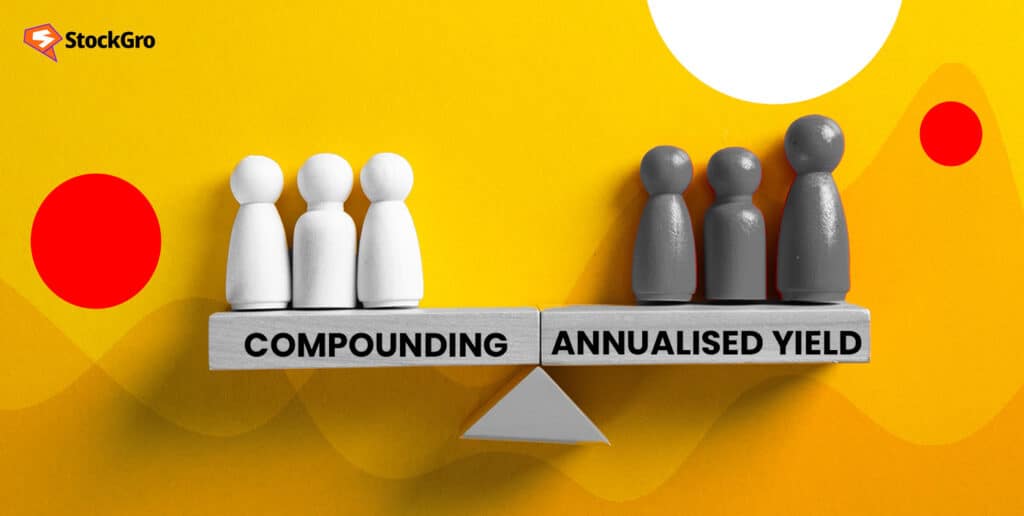
Fixed deposits have always been a popular option among investors seeking portfolio diversification, thanks to their secure and stable yields. This means higher returns, but you should also check the fixed deposit’s compound and annualised yields before investing.
This article will explain these fundamental fixed deposit concepts in simple terms. Read on for an overview of compounding and annualised yields, how to calculate them, and how they differ. This guide will help you gain the clarity you need to make smarter choices when putting money into fixed deposits.
So, let’s begin!
What is the yield on a fixed deposit?
An investment’s yield is the amount of money it makes over a specific time frame, including dividends and interest. Additionally, it lays out the typical rate of return that debt instruments typically provide to investors.
The interest rate on a fixed deposit might help you plan returns over a designated time and plan future expenses accordingly. As a result, you should figure out the interest before you invest so you know how much you may earn.
Fixed deposit schemes use two methods to calculate interest: simple interest and compound interest.
Also read: Deposit Vs. Deposit – Should you invest in FD or RD?
What is a compound interest yield?
The term “compounding” refers to the practice of reinvesting investment profits (such as interest or capital gains) to generate further interest in the future.
The way to get the most out of a fixed deposit (FD) is through compound interest. You may increase your initial investment with interest by placing it in a fixed deposit. What happens is that when you reinvest the capital and the interest that has already been earned, you receive interest on both.
As a result, your profits increase at an exponential rate. Compounding is a powerful tool that allows profits to grow exponentially over time and when reinvestment takes place regularly.
As the frequency of compounding increases, so do the potential rewards. Here, the interest is computed on both the principal and any earned interest.
To illustrate, let’s assume you put ₹1 lakh into a 5-year fixed deposit that pays 8% interest. The interest is compounded annually, so you reinvest it once a year. You may expect to get an interest payment of ₹8,000 in the first year of your investment.
However, if the interest is compounded every three months, Your investment will have a total value of ₹1,08,243 in this scenario. Because of this, you may expect to get an interest payment of ₹8,243.
Compound interest formula
Compound interest’s formula is A= P(1 + R/N)^Nt
Where,
A is the final amount
P stands for the principal amount.
The rate of return on an FD denoted as R
T is the deposit’s term.
Also read: The role of compound interest to reach your financial goals
What is an annualised interest yield?
The actual interest rate you may earn on a fixed deposit when you hold it for more than a year is called the annualised yield in a fixed deposit. An effective annualised yield is found by adding up all of the profits on your fixed deposit using compound interest.
With an annualised yield, you can see the big picture of your returns and make more informed decisions. The interest rate and annualised yield for the fixed deposit you want to invest in are provided by the issuer.
Similar to the interest payment, the yield typically grows with an extended tenure since it depends on fixed deposit rates. However, yield is often greater than FD rates due to its unique calculation method based on interest. You may compare fixed deposit rates and yields on financial markets or the websites or apps of individual issuers.
To understand how much money you may expect to earn from your investment at maturity, use an interest calculator specifically for fixed deposits rather than comparing yields and interest rates. Remember to factor in your tax obligation as well.
How do we calculate the annualised yield?
You may get the yield on your fixed deposit using this easy formula:
APY = (1+i/N) N -1.
In cases when,
“N” is the number of periods used for compounding.
“i” stands for the interest rate.
In addition to the above formula for APY, the following may be used to calculate FD yield:
To calculate the yield on FD, divide the amount received by the initial investment and multiply it by the number of years invested in the scheme.
The annualised yield is the profit you get from an investment divided by the total number of years of the investment.
Also read: Interest rate risk – Meaning and risk management strategies.
Compounding vs. annualised yield
| Term | Definition | Formula | Example |
| Compounding | The process of adding interest to the principal amount and calculating interest on the new balance | A= P(1 + R/N)^Nt | If you invest ₹83,014.74 ($1000) in a fixed deposit for 5 years at an annual interest rate of 10% compounded quarterly, the future value is ₹136,713.39 |
| Annualised yield | The rate of return earned in a single year if the interest is compounded | APY = (1+i/N) N -1 | If you invest ₹83,014.74 in a fixed deposit at an annual interest rate of 10% compounded quarterly, the annualised yield is 10.38% |
Conclusion
Understanding financial mechanics is key to smart investing. This article explained compounding yields and annualised yields in simple terms and provided practical calculation formulas as well as a side-by-side comparison for you to comprehend the terms better.
By having this simple understanding, you will be better equipped to invest in fixed deposits that meet your unique financial goals and objectives.

